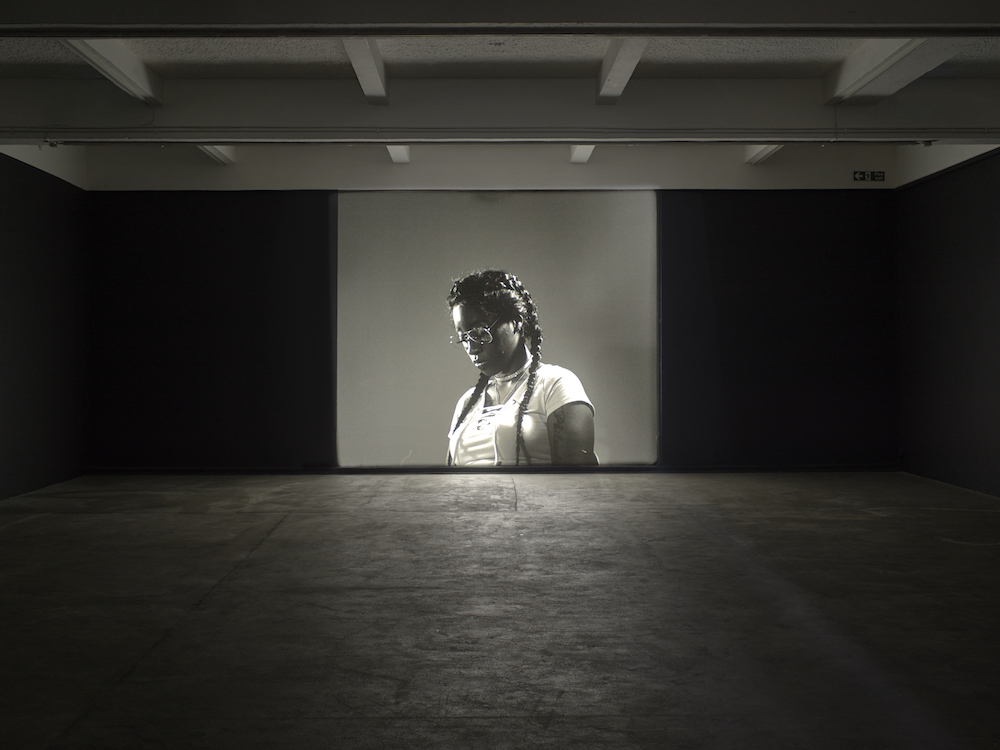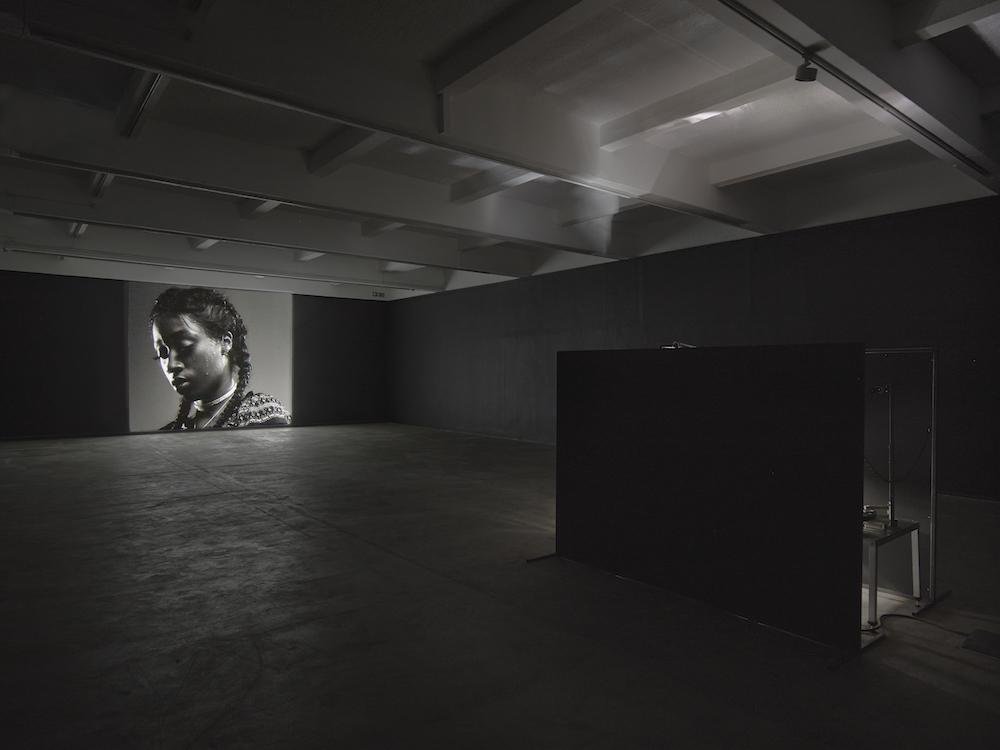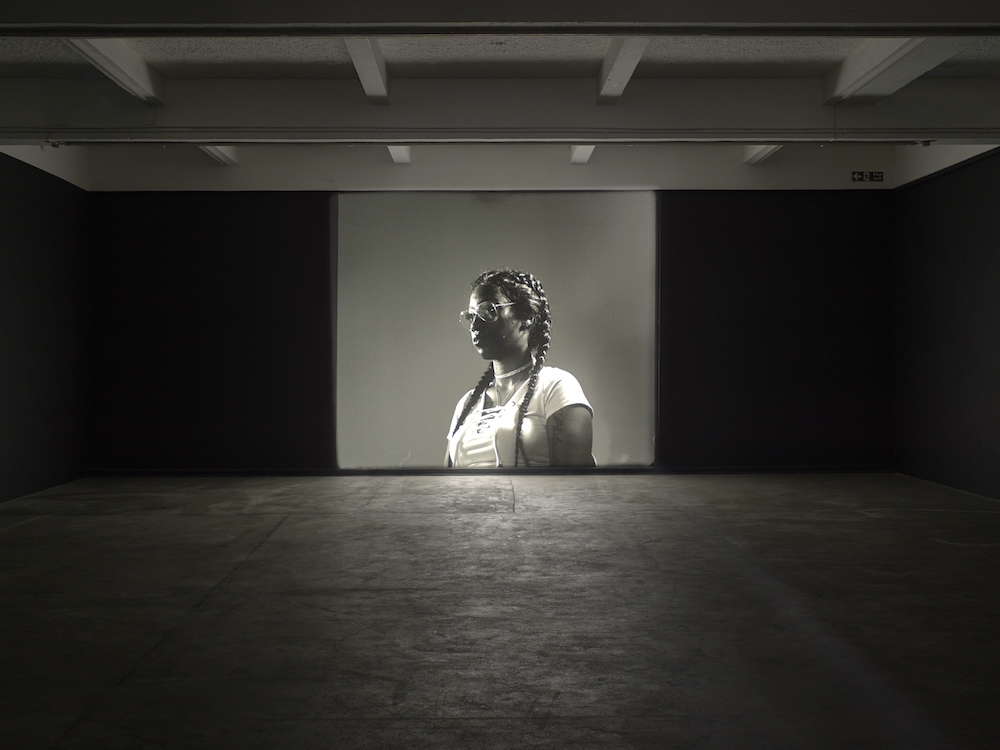Four minutes becomes an eternity under scrutiny. To many of Andy Warhol’s subjects, the Screen Tests (1964–66) were an exercise in self-control. Instructed not to blink into the camera’s flutterless eye, A- and B-list celebrities from Susan Sontag to Edie Sedgwick wrestled with the challenge of appearing themselves. Many crumbled – including the artist Isabelle Collin Dufresne, who, critic Brian Dillon writes, ‘worries that her face simply will not bear such scrutiny, that her image could be quite undone in less than three minutes’.
Diamond Reynolds, the subject of Luke Willis Thompson’s Autoportrait (2017), does not. Shot from below, reified by bold lighting that turns her downcast gaze statuesque, she is the epitome of composure. One witnesses her steadily, alone and undistracted, in two four-minute takes. Just visible between the edge of the screen and the crop of her babydoll tee is a tattoo of her boyfriend’s name: Philando Castile, shot dead by a policeman during a routine traffic stop last year. Reynolds is recognisable to most from her unthinkably lucid livestream of what immediately followed the firing of seven shots, point-blank, into Castile. ‘Because I know that the people are not protected against the police, I wanted to make sure if I died in front of my daughter that people would know the truth,’ she has said about the decision to make public her private apocalypse. Her video joins an emerging canon of witness videos that have exposed police brutality in America and the United Kingdom, catalysing widespread protests and calls for police reform or abolition.
That it must be viewed in the context it was created for is a quiet riposte to the demands of media to perform, articulate, and re-enact one’s trauma in exchange for public sympathy and belief
Reynolds’ image, then, has been shared and disseminated beyond her immediate control. Thompson calls Autoportrait a ‘sister image’, a fittingly sororal term for what can be seen as an act of care. Shot in 35mm Kodak Double-X black-and-white film, Autoportrait is irreproducible without consent, existing offline and without a digital equivalent. That it must be viewed in the context it was created for – in a darkened room, with one’s entire attention given over to it – is a quiet riposte to the demands of media to perform, articulate, and re-enact one’s trauma in exchange for public sympathy and belief. Autoportrait becomes a positive inverse of what Thompson, in a recent interview, called the ‘perverse’ genre of witness videos, whose formal qualities of brevity, pacing and clouded resolution form an aesthetics of trauma itself.

Is it hopeful to consider this portrait’s lifespan as somehow more immutable than the image of Castile’s shooting? Silver and luminescent, the film suggests timelessness. Reynolds’s posture spans history, with more than just the graceful turn of her head suggesting that of a saint’s. Thompson’s film is thus doubly restorative, undoing the horror of the witness video while disqualifying the usual submission required of a portrait-sitter. He has previously used this tactic to consider and rehabilitate the aesthetics of racialised death in Cemetery of Uniforms and Liveries (2016), the silent portraits of two young men whose maternal ancestors had been killed by police. With their similarly clear referencing of the Screen Tests, both works complicate the notion of portraiture itself, questioning the grim nature of contemporary celebrity. If the original point of a screen test was to determine the suitability of an actor for a role, the elision of non-white subjects from the Screen Tests (of the four hundred and seventy-two Tests Warhol produced, only five featured people of colour) exemplifies the biases that scaffold such ideas of suitability. Thompson’s formal appropriation critiques the artifice of Warhol’s neutrality while revising the Screen Tests’ undeniable mystique. The Screen Tests literally exposed glamour, with the short yet slowed format allowing for a glimpse of celebrity aura, and this particular aspect plays powerfully across Reynolds’ new representation: what does it mean that America has made a kind of celebrity of its most gruesomely traumatised citizens, requiring their performance in lieu of due process? Against this effect, Thompson flips the directorial hierarchy. Lighting, angle and framing all reflect Reynolds’ own preferences. In true collaboration with Thompson, she determines the nature of her posterity.

what does it mean that America has made a kind of celebrity of its most gruesomely traumatised citizens, requiring their performance in lieu of due process?
Recovering jurisdiction over one’s own image is a powerful act, both cathartically and politically. Autoportrait can be seen in the context of the portrait of Chelsea Manning commissioned and recirculated by Manning’s supporters after a photograph leaked without Manning’s consent was shared by the press. In both cases, agency is reinstated through the creation of new images, which, in their representation of personal autonomy, speak volumes in the airless chambers of oppression and persecution. Autoportrait was made as a silent film. (Reynolds’ lawyers worried that any recorded speech could be turned against her in court during the case against officer Geronimo Yanez.) Even when the clattering of a projector replaces all sound, and Reynolds’ wordless mouthing looks more like an incantation or a prayer, Autoportrait will always bear relation to Reynolds’ startlingly clear testimony – her piercing address to the world. One week before the exhibition’s opening, Yanez was acquitted. In a statement issued via her lawyers, Reynolds’ response came loud and clear: ‘It is a sad state of affairs when this criminal conduct is condoned simply because Yanez is a policeman. God help America.’
Luke Willis Thompson, Autoportrait is at Chisenhale Gallery, London, through 27 August
